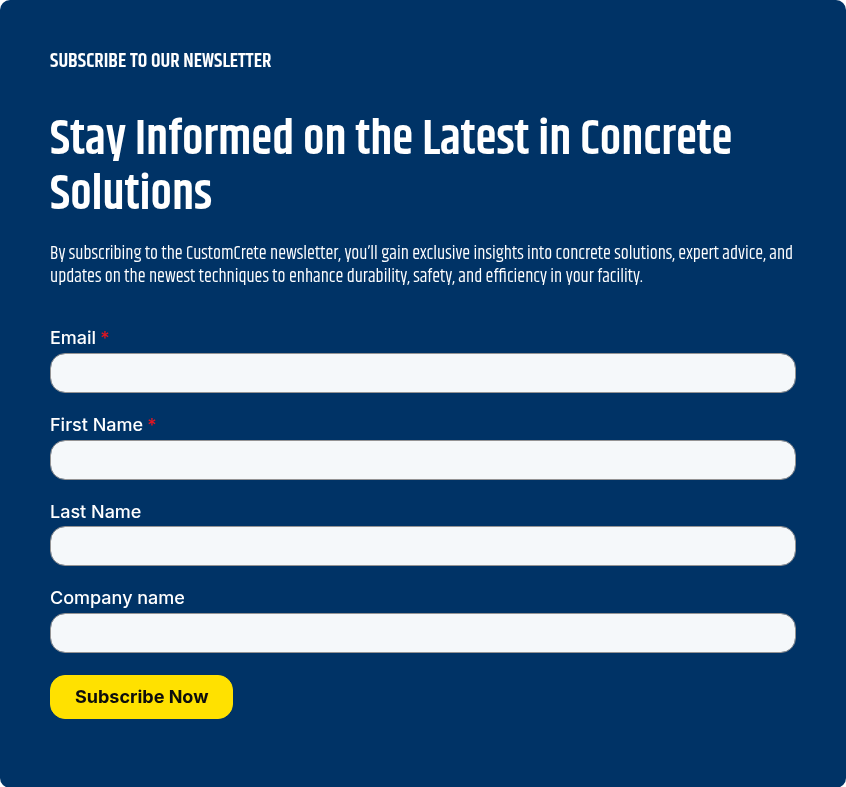How to Ensure Your Concrete Contractor Follows OSHA Guidelines
April 28th, 2025
3 min read
By Tom Dassie

Hiring a concrete contractor isn’t just about finding someone who can pour and finish a slab. For business owners and facility managers, it’s just as important to ensure that the contractor follows proper safety procedures—especially those set by the Occupational Safety and Health Administration (OSHA).
CustomCrete has worked with hundreds of businesses in the Chicago area and understands how critical OSHA compliance is on every job site. A safe work environment isn’t just about protecting workers—it’s also about reducing liability, minimizing disruptions, and staying compliant with federal regulations.
In this guide, we’ll break down the importance of OSHA compliance, what to look for in a contractor, and how OSHA floor marking guidelines factor into the bigger safety picture.
Why OSHA Compliance Matters
OSHA is the federal agency responsible for ensuring safe and healthy working conditions for employees. In the concrete industry, where heavy machinery, hazardous materials, and strenuous labor are routine, safety lapses can lead to serious injuries, costly fines, and project delays.
Hiring a contractor who doesn’t follow OSHA regulations puts everyone at risk. It also reflects poorly on your business and can result in insurance complications, lawsuits, or shutdowns.
By hiring a contractor that follows OSHA guidelines, you ensure:
- Worker safety and reduced injury risk
- Compliance with federal and local laws
- Fewer work stoppages and liabilities
- A professional, organized job site
Key OSHA Requirements for Concrete Contractors
Concrete contractors must follow several safety protocols outlined by OSHA. Some of the most critical ones include:
1. Personal Protective Equipment (PPE)
Workers should wear appropriate PPE, including hard hats, safety goggles, gloves, steel-toed boots, hearing protection, and respirators when necessary.
2. Silica Dust Control
Cutting or grinding concrete can release silica dust, which can cause respiratory illness if inhaled. OSHA requires the use of wet cutting methods, HEPA vacuums, or respiratory protection to minimize exposure.
3. Fall Protection
Contractors must provide fall protection systems such as guardrails or harnesses when working at heights over 6 feet.
4. Tool and Equipment Safety
All machinery and tools must be in proper working condition and used according to manufacturer and OSHA standards. Lockout/tagout procedures should be in place.
5. Hazard Communication
Contractors are responsible for maintaining safety data sheets (SDS) for all chemicals used on-site and ensuring employees understand the risks.
6. Training and Certification
Workers must be trained on job-specific hazards and safety protocols. Certifications for handling equipment like forklifts or aerial lifts are required by OSHA.
Understanding OSHA Floor Marking Guidelines
Floor markings play a vital role in maintaining safety and efficiency on construction and industrial sites. While not exclusive to concrete work, OSHA floor marking guidelines are especially relevant when contractors are working in active facilities or shared spaces.
Key components of floor marking compliance include:
- Color Codes: Yellow is typically used for caution or physical hazards. Red indicates fire equipment or emergency stops. Blue, green, and white have specific roles as well.
- Aisle Marking: Clearly defined walkways for foot traffic help separate workers from moving machinery or hazardous zones.
- Hazard Zones: Striped or cross-hatched patterns can identify dangerous areas, electrical panels, or confined spaces.
When your concrete contractor follows these guidelines, it improves visibility and helps prevent accidents, particularly in manufacturing or warehouse environments.
How to Confirm OSHA Compliance
Here’s how you can make sure the concrete contractor you hire is meeting OSHA’s expectations:
1. Request Their Safety Program
A reputable contractor should have a written safety program outlining their procedures, training, and responsibilities. Ask to see it.
2. Check Certifications and Training Records
Ensure the team is OSHA-10 or OSHA-30 certified and that any specialized training (e.g., silica safety or equipment operation) is up to date.
3. Inspect PPE Use On-Site
If possible, visit a current or recent job site and observe whether workers are consistently using PPE and following safety protocols.
4. Ask About Floor Marking Practices
Especially if the job site is in or near your operational facility, ask how the contractor will address OSHA floor marking guidelines during the project.
5. Review Their Safety History
You can search OSHA’s public database or ask the contractor directly for their safety record, including any past violations or incidents.
6. Look for a Safety-First Culture
Compliance shouldn’t just be on paper. Look for contractors who actively promote safety in their day-to-day practices and make it a core part of their company culture.
Why It Matters for Your Business
Whether you’re managing a warehouse, office building, or industrial plant, your relationship with contractors reflects on your brand. Hiring a contractor that prioritizes OSHA compliance:
- Reduces your risk exposure
- Protects your staff and visitors
- Ensures smoother project execution
- Enhances your professional reputation
Even a minor incident can disrupt business operations or lead to legal trouble, so the cost of hiring a safety-conscious contractor is well worth the investment.
Final Thoughts
Hiring a concrete contractor isn’t just about quality work—it’s about safety, compliance, and professionalism. Understanding and prioritizing OSHA regulations, including OSHA floor marking guidelines, helps you choose the right partner for your next project.
At CustomCrete, we believe that safety and craftsmanship go hand in hand. We follow strict OSHA standards and provide clear communication throughout every stage of a project. Whether it’s floor preparation, concrete polishing, or joint filling, you can trust that the work is done safely and efficiently.
Need help planning your next project? Visit our About page to learn more about CustomCrete or contact our team to request a quote today.

